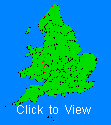 |
Marriage Distribution
Glanville distribution around the country can be determined by examining
Where they married.
I have sufficient coverage (although incomplete) of the records to allow an examination of where the
known marriages took place, in 50 year slices, between 1550 and 1950.
Mainland England and Wales only. Scilly Isles, Channel Isles, Isle of Man, Scottish and Irish records excluded.
A series of maps are presented below, either by specific location within a time window, or a by-county count within a time window.
Known Errors
- I have used my own experiences and judgement (which is not perfect) to decide which spelling variants
to include / exclude as "Glanvilles".
Phonetic spelling, transcription errors, original document mistakes etc etc etc conspire
against exactitude in my analysis.
- Not all marriages that must have taken place have been identified.
For example, parents named in baptismal records, and spouses in census records inform of Glanvilles for whom the marriage record is yet to be found. Hence there are more marriages
than identified here.
- Many of the marriages are of Glanville woman, and some of those will have been Glanville widows remarrying in their previous married name - i.e. they were not born Glanvilles
Maps
Here are the maps, each opens into a new Browser window.
By Location Maps
Each marriage within the year range covered appears as a single white spot geographically located at the town / village.
Other marriages at the same location force an increase in spot size, not additional spots.
Only marriages with a known date and location are used in the generation of the maps.
The Top Towns list the locations with the most marriages recorded in the 50 year period.
Town names such as Bristol, Exeter, Plymouth cover all the church locations within that town, and a single spot covers all the marriages regardless of which church held the marriage.
However, London in the Top Towns is a count of the marriages held within the central parts such as Islington, Westminster, Hackney and Battersea, Wandsworth but each of those districts is shown as a separate map spot.
Greenwich, Ealing, Clapham etc are deemed separate and marriages there do not get counted in the London Top Town, and have their own map spot.
This section includes all the spelling variants I have deemed to refer to Glanvilles.

1551-1600
|
| Top Towns | # Marrs |
|---|
| South Tawton, Devon | 11 |
| Exeter, Devon | 7 |
|
| |

1601-1650
|
| Top Towns | # Marrs |
|---|
| Exeter, Devon | 24 |
| Plymouth, Devon | 18 |
| London | 9 |
| Honiton, Devon | 7 |
| Boyton, Cornwall | 7 |
|
| |

1651-1700
|
| Top Towns | # Marrs |
|---|
| Exeter, Devon | 31 |
| London | 24 |
| Plymouth, Devon | 17 |
| Crediton, Devon | 14 |
| Heavitree, Devon | 7 |
|
|
| |

1701-1750
|
| Top Towns | # Marrs |
|---|
| London | 56 |
| Exeter, Devon | 31 |
| Cheriton Fitzpaine, Devon | 18 |
| Morchard Bishop, Devon | 8 |
| St Columb Minor, Cornwall | 8 |
| St Columb Major, Cornwall | 7 |
|
| |

1751-1800
|
| Top Towns | # Marrs |
|---|
| London | 55 |
| Camborne, Cornwall | 28 |
| Cheriton Fitzpaine, Devon | 18 |
| Stoke Damerel, Devon | 19 |
| Exeter, Devon | 16 |
| Newlyn East, Cornwall | 12 |
|
| |

1801-1850
|
| Top Towns | # Marrs |
|---|
| London | 55 |
| Camborne, Cornwall | 28 |
| Cheriton Fitzpaine, Devon | 18 |
| Stoke Damerel, Devon | 19 |
| Exeter, Devon | 16 |
| Newlyn East, Cornwall | 12 |
|
|
| |

1851-1900
|
| Top Towns | # Marrs |
|---|
| London | 229 |
| Plymouth, Devon | 114 |
| Exeter, Devon | 44 |
| Redruth, Cornwall | 35 |
| Camborne, Cornwall | 29 |
| Bristol, Gloucs | 28 |
|
| |

1901-1950
|
| Top Towns | # Marrs |
|---|
| London | 203 |
| Plymouth, Devon | 173 |
| Bristol, Gloucs | 74 |
| Portsmouth, Hants | 64 |
| Exeter, Devon | 56 |
| Redruth, Cornwall | 52 |
|
| |

1951-2000
|
| Top Towns | # Marrs |
|---|
| Plymouth, Devon | 157 |
| London | 113 |
| Bristol, Gloucs | 69 |
| Exeter, Devon | 37 |
| St Austell, Cornwall | 31 |
| Chatham, Kent | 30 |
|
|
| |
Counts by County
The migration of Glanvilles out of Devon and Cornwall can be seen by the following maps showing the Ancient Counties and the number of Glanville
marriages taking place within them in the last 250 years.
As the previous maps showed more clearly, the marriages were not evenly distributed across counties, but focussed on specific locations such as the population centres (and naval bases)
of Plymouth, Portsmouth, Chatham and Bristol. However, the by-county count, makes clear the summation of marriages in more rural areas where the per-location count may be low (and less
visible on the earlier maps), but together there are significant Glanville marriages in a region as a whole (e.g. Yorkshire 1901-1950.) |
| |

1751-1800
|

1801-1850
|

1851-1900
|

1901-1950
|

1951-2000
|
|


